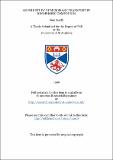Files in this item
An NMR study of membrane transport by ionophoric compounds
Item metadata
| dc.contributor.advisor | Riddell, Frank | |
| dc.contributor.author | Sareth, Sina | |
| dc.coverage.spatial | 151 p. | en_US |
| dc.date.accessioned | 2018-06-13T12:55:06Z | |
| dc.date.available | 2018-06-13T12:55:06Z | |
| dc.date.issued | 1998 | |
| dc.identifier.uri | https://hdl.handle.net/10023/14008 | |
| dc.description.abstract | The first part of this thesis consists of a study of the transport of alkali metal cations across model biological membranes mediated by ionophoric antibiotic cationomycin. The transport rates were measured by 23Na and 39K NMR using large unilamellar vesicles (LUVs) prepared from phosphatidylcholine and were compared with results obtained using red blood cells. These kinetic studies have established that there is a 1:1 complex between alkali cations and the cationomycin during the transport process. The transport rate measured are comparable to those of other ionophoric antibiotics studied previously. Cationomycin transports potassium cation more rapidly than sodium cation, and forms a more stable complex with potassium cation. The rate limiting step in the transport process is release of the cation at the membrane surface. The second part involves the study of spirotetrahydrofuran analogues as potential alkali cation transporters. A set of new synthetic ionophoric materials designed to resemble to some degree the naturally occurring ionophoric antibiotics was investigated. The kinetic rates of these compounds were measured in phosphatidylcholine LUVs by an NMR study of 7Li/23Na exchange. However, these compounds are much poorer transporters than the ionophoric antibiotics which are 10<p> times faster under similar conditions. The third part of this project deals with the study of the transport of halide anions by steroid-based anionophores. The transport rates of these compounds were measured by an NMR study of 35Cl/81Br exchange in phosphatidylcholine LUVs. This preliminary study indicates a close relationship between the lipophilicity of the different anionophores and the transport rates of different halides anions through the model membrane. The final part of this thesis involves the total assignment of the 1H and 13C NMR spectra of the ionophoric antibiotic tetronasin by utilising two dimensional NMR techniques such as COSY 45, Relay COSY, DQF COSY, TOCSY and HSQC. | en_US |
| dc.language.iso | en | en_US |
| dc.publisher | University of St Andrews | |
| dc.subject.lcc | QH603.I7S2 | en |
| dc.subject.lcsh | Membranes (Biology) | en |
| dc.title | An NMR study of membrane transport by ionophoric compounds | en_US |
| dc.type | Thesis | en_US |
| dc.type.qualificationlevel | Doctoral | en_US |
| dc.type.qualificationname | PhD Doctor of Philosophy | en_US |
| dc.publisher.institution | The University of St Andrews | en_US |
This item appears in the following Collection(s)
Items in the St Andrews Research Repository are protected by copyright, with all rights reserved, unless otherwise indicated.

